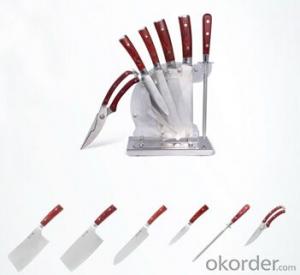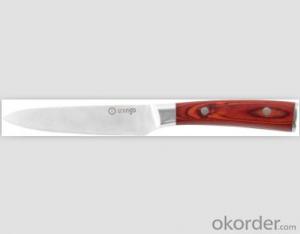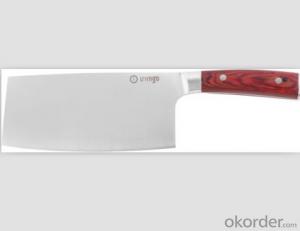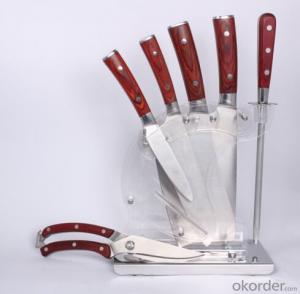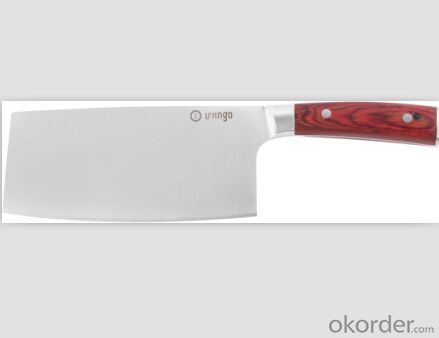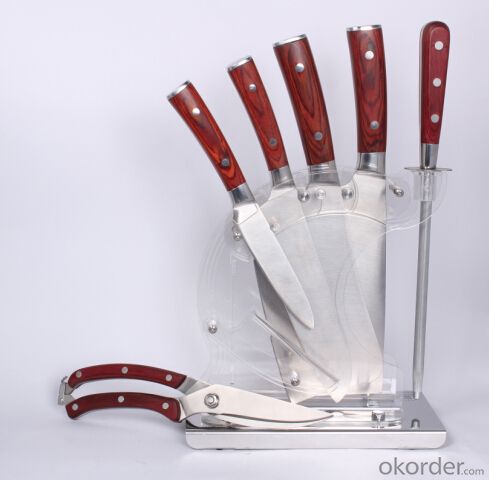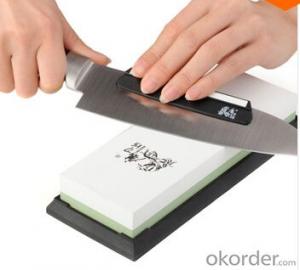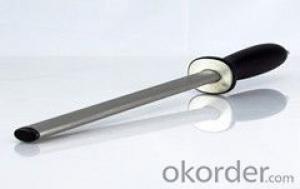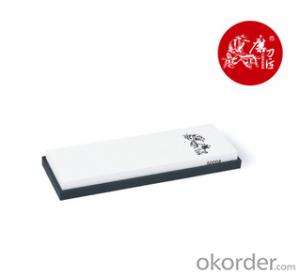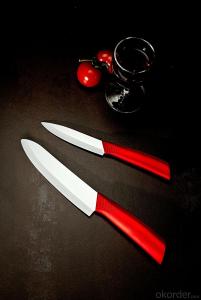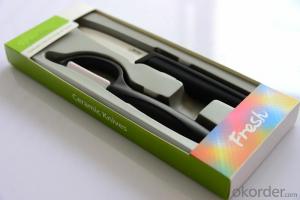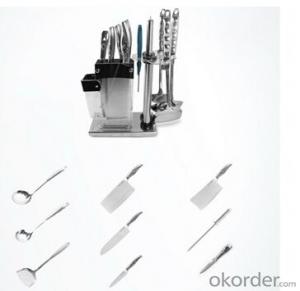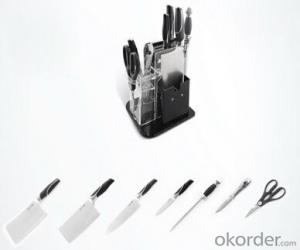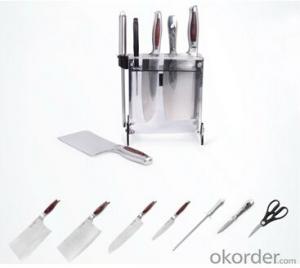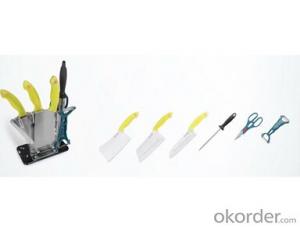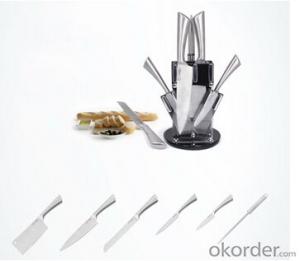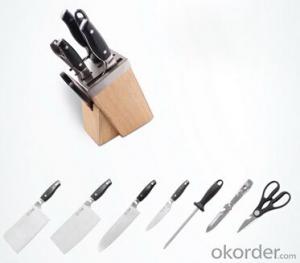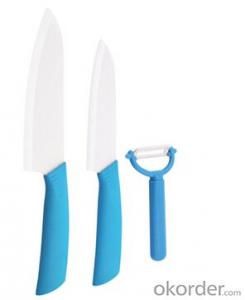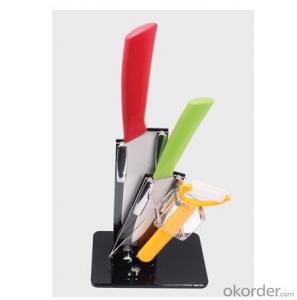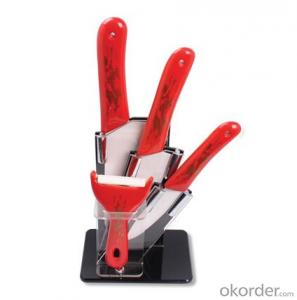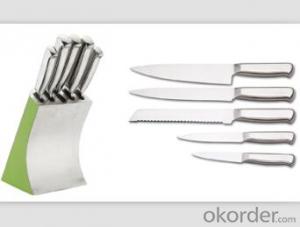Art no. HT-KS1017 Stainless steel knife set
- Loading Port:
- Guangzhou
- Payment Terms:
- TT OR LC
- Min Order Qty:
- 1000 PCS
- Supply Capability:
- 100000 PCS/month
OKorder Service Pledge
OKorder Financial Service
You Might Also Like
Set includes:
1 × kitchen scissor
1 × sharpener
1 × fruit knife
1 × carving knife
1 × cleaver
1 × chopping knife
1 × acrylic knife holder
High-carbon stainless steel blade holds a superior sharp edge
High quality stainless steel,tool vertical tough strong corrosion resistance
Comfortable grip handle for balance and control
Many other designs are available
Customized orders are accepted
Features:
No slot foldable magnetic wooden knife block
Seamless welding technique
Fashionable and comfortable handle design
Multifunction kitchen knife set meets customer's needs during cooking
Primary Competitive Advantages:
Brand-name Parts Country of Origin
Distributorships Offered Electronic Link
Experienced Staff Form A
Green Product Guarantee/Warranty
International Approvals Packaging
Price Product Features
Product Performance Quality Approvals
Reputation Service
Main Export Markets:
Eastern Europe North America
Mid East/Africa Central/South America
Asia Western Europe
- Q: What tools have both toughness and wear resistance
- High carbon steel:High carbon steel turning tool is a kind of carbon steel with carbon content of 0.8%~1.5%, which is used after quenching and hardening. Because of the friction in the cutting process, it is easy to be tempered and softened by four. Generally only suitable for cutting soft metal materials, commonly used SK1, SK2,,, SK7, etc..
- Q: What is the classification of the hardness level?
- Hard alloy tool hardness is generally between HRA89.5~92.8, the hardness of HSS is generally between HRC62~65, super hard high speed steel hardness is between HRC69~70, the hardness of carbon tool steel in general about HRC62, the hardness of diamond in the HV10000, the hardness of silicon carbide in HV4500, titanium carbide coating hardness HV3800, corundum hardness in the HV2400, tungsten carbide hard alloy hardness in 1300.
- Q: What are the advantages of ceramic knives?
- Love home ceramic knife handle according to the human engineering design, not only considering the action and strength when cutting, and the curve of stability and the shape of the handle, it makes the operation more stable, perfect cut and eat freely.
- Q: Excuse me, master, difference, white steel cutter and tungsten steel knives advantages, what are the disadvantages?
- Is the cost difference. White steel knife mostly refers to high-speed steel cutting tools, high-speed steel (HSS - HIGH SPEED STEEL) is the most common material SKH9, hardening heat treatment to about HRC64. The cost is low by cutting tool steel, the hardness of the workpiece is low, is the most traditional tool. The car is tungsten steel knife the hardness of HRA90-93, harder and more than high-speed steel tool with cutting force, service life is long, but also more expensive.
- Q: Processing 316 stainless steel should be very sticky knife, how to choose the tool?
- We used to use ceramic cutter head, alloy knife head is easy to stick knife
- Q: What are the reasonable tool life?
- Production line tool durability should be defined as a class or two class, in order to change the knife at the end of the shift.
- Q: I know that there are two numbered Rules, one of which is T0101, T0202, T0303, T0404, etc.There is a T0101, T0102, T0103, T0104, such as the number, under the advice of the two numbersCan it be mixed? If you can, how to determine the knife mark?
- Yes, don't get too caught up in it. The tool and knife mark are not necessarily linked, the tool number is fixed, the knife mark is alive.
- Q: What is the sintering and electroplating tools ah? What is the difference?
- Sintering definition:Macro definition: at high temperature (not higher than the melting point), other key green ceramic particles, grain growth, voids (pores) and grain boundary gradually reduced by the material transfer, the total volume shrinkage, density increases, and finally become a dense microstructure of polycrystalline sintered body, this phenomenon is called sintering.Microscopic definition: solid molecular (or atomic) are attracted to each other, by heating the particles to obtain enough energy for migration, make the powder particles bond, produce strength and lead to the densification and recrystallization process called sintering.
- Q: What do PCD cutters and PCBN cutters mean?
- CBN has high hardness, chemical inertness and thermal stability at high temperature, so it is widely used in grinding process as abrasive CBN grinding wheel. Due to the characteristics of CBN is superior to other tool materials, so people began to be applied to machining, but the small particles of CBN single crystal, it is difficult to make the tool, and the sintering of CBN is very poor, it is hard to be made of CBN sintered body, the larger until 1970s, the Soviet Union, China, countries such as Britain and the United States it have been successfully developed as CBN sintered, polycrystalline cubic boron nitride cutting tool PCBN (Polycrystalline Cubic Boron Nitride). Since then, PCBN with its superior cutting performance in various areas of cutting applications, especially in the high hardness materials, difficult machining materials in the cutting process is unique. After more than 30 years of development and application, there have been used to process different materials PCBN cutter material.
- Q: How to improve the service life of cutting tools
- Low speed big cutting knife walking so as not to water injection for stripHigh speed small knife such fine work late quickly but also left 50 children with light alloy knife sideThis is the usual work of ferroalloy
Send your message to us
Art no. HT-KS1017 Stainless steel knife set
- Loading Port:
- Guangzhou
- Payment Terms:
- TT OR LC
- Min Order Qty:
- 1000 PCS
- Supply Capability:
- 100000 PCS/month
OKorder Service Pledge
OKorder Financial Service
Similar products
Hot products
Hot Searches
Related keywords
